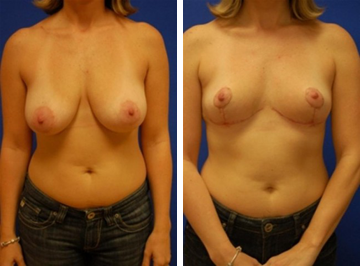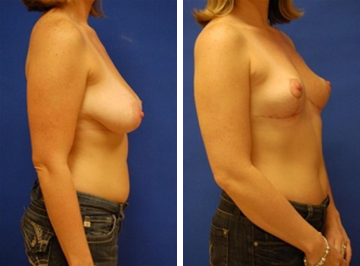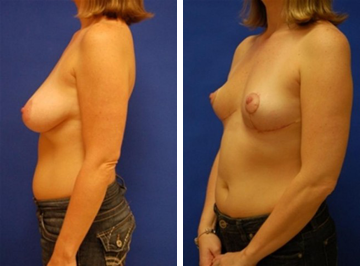Breast Reduction Mobile, AL
Jump To
Dr. Randy Proffitt regularly performs breast reductions in Mobile. According to the American Society for Aesthetic Plastic Surgery, there were 138,152 breast reduction cases performed in 2010. Breast augmentation (implants) is frequently in the news and in magazines, but breast reduction is as common of a procedure as breast enlargement.
Many women have back, neck and shoulder pain due to the excessive weight of their breasts. Bras are only designed to transfer the weight to the back and shoulders. A good support bra doesn’t treat the underlying cause. The most common comment from patients a month after surgery is “I wish I had done it sooner.”
What Patient Are Saying About Their Breast Reduction
Will Insurance Pay for It?
A breast reduction is a covered surgery by most insurance companies. Unlike breast augmentation or a breast lift, a breast reduction is considered reconstructive surgery because a medical problem is being treated. However, insurance companies also require a minimum amount of breast tissue (by weight) to be removed and that physical problems be directly related to excessively large breasts.
If you suffer from the following symptoms, you may be a good candidate for a breast reduction:
- Back, shoulder and /or neck pain
- Shoulder grooving/indentations from bra shoulder straps
- Had to have a custom bra fitted
- Rashes on the undersurface of breasts
At your consultation, Dr. Proffitt will discuss your medical history and take physical measurements. This information along with photographs is then sent to your insurance company in order to see if you meet their criteria for medical necessity.
View more plastic surgery photos
How Is the Surgery Performed?
Dr. Proffitt performs breast reductions under general anesthesia with the supervision of a board-certified anesthesiologist. Dr. Proffitt usually takes 1 ½ to 2 hours to complete a breast reduction. Both breast tissue and skin are removed, and surgical scars are on the lower aspect of the breast so that any scars are well hidden by clothing and bathing suit tops.
Additionally, liposuction is regularly performed lateral to each breast to help the overall result. The nipple remains attached to the remaining breast tissue at all times. Areola reduction may occur so that it can better fit the breast’s new proportions. No drains are used.
A bandage is then placed at the time of surgery and remains in place for the first 2 to 4 days. Your bandages will be removed at your first postoperative appointment and you are then placed in a support bra. The support bra should be worn for the next 6 weeks.
Where Is the Surgery Performed?
Dr. Proffitt performs breast reductions in an outpatient setting under general anesthesia. Exceptions may include those patients from out of town or if other procedures are combined with breast reduction. Also anyone with medical conditions that would warrant longer inpatient observation and monitoring.
What Is the Recovery Time?
Most people can resume normal activities in 1 to 2 weeks. However you should not lift more than 10 pounds for 3 weeks or engage in strenuous activities for 6 weeks. At 3 weeks, stitches (3) on each breast will be removed. All remaining sutures are absorbable. Incisions will remain red for 2 to 3 months.
What Are the Risks?
- As with any surgery and although infrequent, there is always a slight risk of bleeding and infection.
- Occasionally a loss in sensation in the nipple or breast may occur.
- If you are considering breast feeding in the future, please consider that although breast feeding after reduction has been reported, it is rare.
- If you smoke, you must stop all nicotine products for at least 6 weeks prior to surgery. This includes nicotine patches and gums, and electronic cigarettes. Nicotine compromises blood supply and may result in loss of breast tissue or nipples.
What Will Be My Result?
Although breast reduction is a medically necessary surgery that doesn’t mean that the results won’t be cosmetically improved. Dr. Proffitt tries to achieve your preference for breast size while meeting the requirements stipulated by your insurance company, and achieving symmetry.
Click here to Schedule Your Breast Reduction with Dr. Proffitt.
More information about Breast Reduction – by Dr. Randy Proffitt
What is a breast reduction?
A breast reduction is a procedure to reduce the weight and size of the breast. The same procedure in males is called gynecomastia reduction, which is a separate topic.
What does a breast reduction entail?
It is a surgical operation that takes me approximately 1 ½-2 hours to complete and involves removing some of the skin, breast tissue, and fat from the breast. In addition, for best results, I often perform liposuction on the sides of the chest wall, not in the breast itself.
Most women with large breasts have fat in this area, so when the breast is reduced in size, if liposuction is not done, it can look “funny” in this area. It also helps to prevent what plastic surgeons call dog-ears, which is a puckering of the incision at the sides. This is a normal and basic part of the procedure, so it is not billed separately and does not add more than 10 minutes to the procedure.
How do we perform the operation?
This surgery is generally done on an outpatient basis where the patient arrives at the hospital two hours before their surgery, undergoes the 2 hour procedure, and after one to two hours of recovery goes home. This surgery is performed under general anesthesia which means the patient is asleep during the surgery.
Depending on the day of the week it is performed, I usually see them back within 2-4 days and remove the bandages and then place the patient into a support bra. In my office, we stock all different sizes of support bras so they get a custom fit and I know that they are wearing the correct bra during their recovery period. These bras are available at a minimal charge.
Who is a good candidate for the procedure?
This operation is not considered a cosmetic operation but it is considered a reconstructive procedure. With that in mind, its cost generally is covered by insurance.
So, who is a good candidate? The general symptoms that people have from excessively large breast include, back pain, neck pain, shoulder pain, indentations in the shoulder, and chafing or rashes on the undersurface of the breasts. Frequently people have discoloration where the bra strap has caused grooving in the shoulders as well.
Often in order to obtain approval for surgery from the insurance company, there may be some additional requirements. These may include that the patient has seen another doctor and ruled out any back problems due to other problems other than large breasts and/or may have undergone some physical therapy or chiropractic treatment for their back or shoulder discomfort.
The next step is to determine whether this procedure’s price will be covered with insurance by examining and measuring the breasts. Most insurance companies require that a particular amount of breast tissue be removed at the time of surgery. Some insurance companies have a flat weight requirement that needs to be removed from the breasts and other insurance companies use a sliding scale that correlates with the patient’s height and weight. All of these can be determined at the time of consultation.
What are the realistic expectations for a patient having a breast reduction?
The most common remark I hear is that patients wish they had this surgery earlier. Patients who have undergone this procedure are some of the happiest patients I have. In general, I try to get patients to a B or C cup size.
We don’t want to take so much breast tissue that the patient does not look feminine, but on the other hand, we want to remove enough that the patient’s symptoms of back, neck, and shoulder pain are relieved. Many of my patients who have had headaches prior to the operation report that their headaches go away after the procedure.
Many patients come in and ask whether their breasts will be lifted at the same time and this certainly is an integral part of the operation, so, in addition to removing some of the weight and volume of the breasts, the nipple is placed into a more youthful position and level on the chest wall so that there is an overall more youthful appearance of their breasts.
How long does it take for the patient to recover?
As mentioned the patients come back 2-4 days after the operation to have their bandages removed and to be placed into a support bra which is worn for six weeks 24 /7. Once they are placed in the support bra they can shower and wash as needed, including washing the breasts and incisions. Of course the bra may be taken off for showering.
Most of the sutures are underneath the skin and are absorbable so they will not need to be taken out, however, there are 3 sutures on each breast that do need to be removed about 3 weeks after the operation. These are removed in the office.
No driving for at least one week and no lifting more than 10 pounds or reaching above your head for three weeks. No strenuous exercise for at least 6 weeks. IF your job does not require you to lift more than 10 pounds, you may return to work after one to two weeks.
When you are ready to discuss breast reduction in Mobile, AL, with a board-certified plastic surgeon, contact the practice of Dr. Randy Proffitt. Call 251-344-0322 or use the online email form to get in touch with our friendly staff. View a map to our office.





